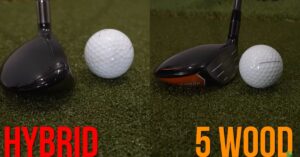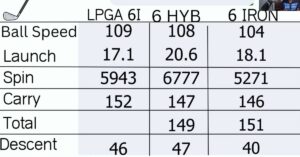Fairway Wood Vs Driver: Exploring the Differences
Choosing the right club can make all the difference in a golfer’s game. When it comes to long shots off the tee, two popular options are the fairway wood and driver. But what sets them apart?
A fairway wood has a shorter shaft and higher loft angle than a driver, making it easier to control on the fairway. However, a driver has a longer shaft and lower loft angle, making it ideal for long-distance tee shots.
In this article, we’ll explore the differences between these two clubs to help you make an informed decision about which one is right for you.
What Are The Similarities Between Fairway Wood Vs Driver

Fairway woods and drivers are both long clubs that are used to hit the ball long distances. They are both made of metal and have a large clubhead with a shallow face.
Length and Clubhead Speed
Both fairway woods and drivers are long clubs designed to maximize clubhead speed. Fairway woods typically range from 42 to 45 inches, while drivers are slightly longer, ranging from 44 to 46 inches.
This extended length allows golfers to generate more clubhead speed, resulting in greater ball distance when struck effectively.
Construction with Metal
While both clubs were originally crafted from wood, they have evolved to be predominantly made of metal, such as titanium or steel.
This transition to metal construction enhances their strength and durability, ensuring they can withstand the forces of high-speed swings and repeated impacts.
Large Clubhead
Fairway woods and drivers share the characteristic of having a relatively large clubhead, varying in volume from 175 to 460 cubic centimeters.
The larger clubhead size increases the sweet spot area on the clubface. When the ball is struck within this region, it results in more distance and better ball flight.
Shallow Face and Loft
Both clubs have shallow clubface designs, with lofts ranging from 13 to 19 degrees.
This shallow face aids in launching the ball higher into the air, an advantage for golfers who struggle with low trajectory shots. The loft also contributes to the ball’s initial launch angle, which impacts distance and carry.
Intended for Distance Shots
Fairway woods and drivers are specialized for hitting long distances. Golfers use these clubs off the tee or from the fairway when seeking to cover substantial yardages.
While they may sacrifice some accuracy compared to irons, their ability to propel the ball farther is their primary asset.
Fairway Wood Vs Driver: Quick Comparison Table

They both offer the potential for long-distance shots, but they have different strengths and weaknesses. This table provides a quick comparison of the two clubs, so you can decide which one is right for you.
| Feature | Fairway Wood | Driver |
| Clubhead size | Smaller | Larger |
| Clubhead loft | Higher | Lower |
| Ball flight | Higher | Lower |
| Distance | Shorter | Longer |
| Forgiveness | Less | More |
| Versatility | More | Less |
| Ideal shot | Approach shots, tight lies | Tee shots |
How Do The Differences Between Fairway Wood Vs Driver Impact The Game?
Fairway woods and drivers are both essential clubs in a golfer’s bag, but they have distinct characteristics that can significantly impact the game. Here are the main differences and their effects on the game:
Loft
Fairway woods typically have higher lofts, ranging from 12 to 20 degrees. The higher loft helps launch the ball higher and with more spin, making them ideal for shots from the fairway or semi-rough. They are also useful for hitting off the tee on shorter or tighter holes.
Drivers have lower lofts, usually ranging from 8 to 12 degrees. The lower loft minimizes backspin, resulting in a more penetrating ball flight with greater distance off the tee.
Distance
Fairway woods are generally shorter in shaft length compared to drivers, which may reduce clubhead speed and distance off the tee. However, they are designed for control and versatility, making them useful for approach shots on long par-4s or par-5s.
Drivers are designed primarily for distance off the tee. With their longer shafts and lower loft, they allow golfers to maximize their clubhead speed and achieve greater distance on their drives.
Tee Shots vs. Fairway Shots
Fairway woods are excellent choices for hitting the ball off the fairway or from light rough. Their design promotes a higher trajectory and more forgiveness, making them easier to control on shots where accuracy is crucial.
The driver is the go-to club for tee shots, especially on longer par-4s and par-5s. Its design emphasizes distance, making it perfect for giving the ball an extra boost off the tee.
Forgiveness
Fairway woods are generally more forgiving than drivers. They have a smaller clubhead and a shallower face, which helps distribute weight and provide a larger sweet spot, reducing the impact of off-center hits.
Drivers are less forgiving due to their larger clubheads and deeper faces. Off-center hits are more likely to result in a loss of distance and accuracy.
Fairway Wood Vs Driver: Which One Is Better?
There is no one-size-fits-all answer to this question, as the best club for you will depend on your individual swing speed, accuracy, and preferences. However, there are some general guidelines that can help you decide which club is right for you.
Drivers are typically better for golfers with high swing speeds who are looking for maximum distance. They have less loft than fairway woods, which means that they produce a lower trajectory and more roll-out. However, drivers can be more difficult to control, especially golfers with slower swing speeds.
Fairway woods are typically better for golfers with slower swing speeds who are looking for more control. They have more loft than drivers, which means that they produce a higher trajectory and less roll-out. Fairway woods are also typically easier to control than drivers, making them a good choice for golfers who struggle with accuracy.
Ultimately, the best way to decide which club is right for you is to experiment with both drivers and fairway woods and see which one you hit better. You may also want to talk to a golf instructor who can help you assess your swing and make recommendations.
Frequently Asked Questions
As a golfer, choosing the right club can be a daunting task. Two popular options for long shots off the tee are the fairway wood and driver. But what sets them apart? Here are some FAQs to help you decide which club is right for you.
What Is A Fairway Wood?
A fairway wood is a club designed for long shots on the fairway. It has a shorter shaft and higher loft angle than a driver, making it easier to control.
What Is A Driver?
A driver, also known as a 1 wood, is typically the longest club in a golfer’s bag. It is designed to hit the ball the farthest distance off the tee.
Which Club Is Easier To Hit?
Generally, a fairway wood is easier to hit than a driver due to its shorter shaft and higher loft angle. However, this can vary depending on the golfer’s skill level and swing style.
Which Club Is Better For Distance?
A driver is typically better for distance due to its longer shaft and lower loft angle. However, this also depends on the golfer’s skill level and swing style.
Which Club Is Better For Accuracy?
A fairway wood is typically better for accuracy due to its shorter shaft and higher loft angle. However, again, this can depend on the golfer’s skill level and swing style.
Can A Fairway Wood Be Used Off The Tee?
Yes, a fairway wood can be used off the tee for shorter holes or when accuracy is more important than distance.
Should I Carry Both A Fairway Wood And Driver In My Bag?
It depends on your personal preference and skill level. Some golfers prefer to carry both clubs for different situations, while others may only carry one or the other.
Conclusion
The best way to choose between a fairway wood and a driver is to consider your own playing style and preferences.
If you are looking for a club that is easy to hit and offers good control, then a fairway wood may be a better option for you. If you are looking for a club that can generate maximum distance, then a driver may be a better choice.
Ultimately, the best way to decide is to try out both clubs and see which one you prefer.






